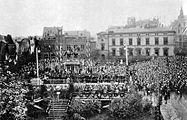Kaiser Wilhelm Monument (Essen)
The Kaiser Wilhelm Memorial in Essen city center is an equestrian statue that Kaiser Wilhelm I represent. As one of numerous Kaiser Wilhelm monuments that were erected during the German Empire , this also glorifies Wilhelm I as its founder and as the victor over the Second Empire (France).
Relation to the city of Essen
Wilhelm I became the first German Emperor after his victory in the Franco-Prussian War 1870–1871 . This victory and thus the founding of the empire is attributed to Alfred Krupp's steel cannons , among other things , as these had a range that was almost twice that of French bronze cannons. Krupp produced them in his cast steel factory in the west of Essen. Emperor Wilhelm I therefore visited Essen several times, most recently in 1886.
The monument
The bronze equestrian statue depicting Kaiser Wilhelm I as a general in a general's uniform with a cloak and spiked bonnet was designed by Hermann Volz . After the foundation stone was laid on August 26, 1898, without a special celebration, the entire monument was inaugurated on October 23, 1898 in the middle of Burgplatz .
Most of the costs were paid by voluntary donors from the Essen bourgeoisie. The industrialist Friedrich Alfred Krupp and the patrician and industrial family Waldthausen were among the largest single donors with 20,000 marks each . A total of 116,000 marks were raised in donations. After two unsuccessful tenders, in which the monument commission did not find anyone suitable, the now appointed professor of the State Academy of Fine Arts in Karlsruhe , Hermann Volz, created the 4.5 meter high bronze equestrian statue.
The terrace as a substructure was carried out by the town planning officer Wiebe and cost an additional 65,000 marks, which were borne by the city. It consisted of Swedish granite with a blacksmith iron border. The terrace height on the low Burgplatz was adjusted to the level of Burgstrasse (today Kettwiger Strasse ) so that it could be reached from Burgstrasse with five steps and from the eastern side with 19 steps made of Odenwald sandstone . The terrace with a mosaic floor had an area of 28.4 by 17.6 meters.
The monument base made of green Odenwald syenite and gray granite, which stood on the terrace, measured 3.4 by 6.63 meters and was four meters high. At its front facing Burgstrasse, a lion, ready to jump, was sitting on the built-in pedestal steps, protecting the coat of arms of the empire. Above the lion was the inscription on a sign:
"Wilhelm the Great, German Emperor, King of Prussia."
Above it was a banner with the emperor's motto:
"My powers belong to the world and the fatherland."
And over this band lay the imperial crown. The northern long side of the base bore the inscription:
“The grave fate that I saw in my childhood, the loss of my unforgettable, dear, beloved mother so early on, filled my heart with seriousness from an early age. Taking part in the uprising of the Fatherland was the first point of light in my life. Coblenz, April 10, 1857. "
The southern long side of the base bore the inscription:
“But God wants to grant us and our successors at the imperial crown to always be multiples of the German Empire, not in military conquests, but in the goods and gifts of peace in the field of national welfare, freedom and morality. Versailles, January 18, 1871. "
And finally on the back of the monument was written:
"The grateful city of Essen"
.
Inauguration on October 23, 1898 on Burgplatz
The monument on the still sloping Burgplatz, behind from left to right: House of the Huyssen family , St. Johann Baptist , Essen Minster
Relocation of the monument
In the course of a comprehensive redesign of the inner city, an urban planning concept was sought in a first architecture competition in 1924 to redesign the Burgplatz in a big city. As a result, the area of the square, which had previously sloped to the east, was straightened and connected to Burgstrasse with a wide staircase. In 1928, the equestrian statue was finally moved to its present location on the southwestern edge of Burgplatz, near the Lichtburg building , directly on Burgstrasse, with a new, simplified base without a terrace.
On September 8, 1994, the Kaiser Wilhelm Memorial was placed under monument protection.
Web links
Individual evidence
- ↑ a b c T. Kellen: The industrial city of Essen in words and pictures. History and description of the city of Essen. At the same time a guide through food and the surrounding area. Fredebeul & Koenen, Essen 1902.
- ↑ Excerpt from the list of monuments of the city of Essen ; accessed on November 16, 2016 (PDF document)
Coordinates: 51 ° 27 ′ 18.3 " N , 7 ° 0 ′ 47" E



